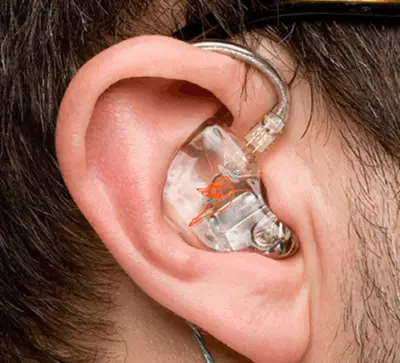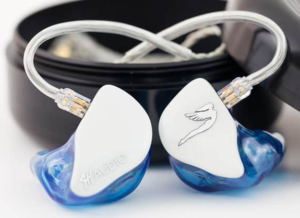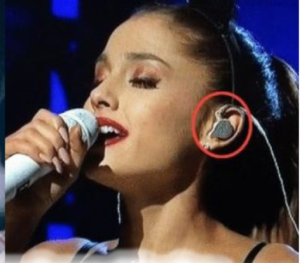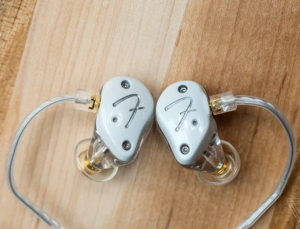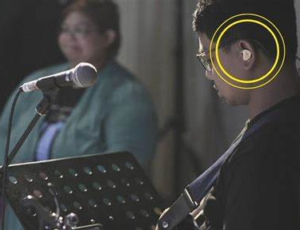In the electrifying world of live music performances, there’s more to the stage than meets the eye. We’ve all seen those mysterious earpieces tucked snugly into their ears. What do singers hear in their earpieces? It’s a question that has long intrigued audiences, and as we delve into the enigmatic world of stagecraft, we’ll uncover the well-guarded secrets that these tiny devices deliver to our musical icons.
Singers wear earpieces, also known as in-ear monitors (IEMs), for a variety of reasons. The most important reason is to hear themselves clearly over the noise of the stage. IEMs provide a direct source of sound, which allows singers to monitor their pitch and stay in time with the band.
Another reason singers wear IEMs is to protect their hearing. Stage monitors are often very loud, and prolonged exposure to loud noise can cause hearing damage. IEMs allow singers to control the volume of their own sound, so they can protect their hearing without sacrificing their ability to hear themselves.
In addition to hearing themselves and protecting their hearing, singers may also use IEMs to hear other things, such as metronome or click track to help them stay in time, backing tracks of instruments or vocals, and cues from the sound engineer or other musicians.
What is the purpose of earpieces for singers?
Earpieces for singers are called in-ear monitors (IEMs). They are small, custom-molded earbuds that provide singers with a direct source of sound. IEMs are used for a variety of reasons, including:
- Hearing protection: IEMs block out loud noises from the stage, such as from the band or other performers. This helps to protect singers’ hearing from damage.
- Monitoring: IEMs allow singers to hear themselves clearly, even over the loud sounds of the stage. This helps them to stay in pitch and sing accurately.
- Customization: Singers can customize the mix of their IEMs to their own preferences. For example, they can choose to hear more of their own voice or more of the band. This can help them to perform at their best.
IEMs are also popular with other musicians, such as drummers and guitarists. They are also used by other performers, such as actors and dancers.
Do singers use in-ear monitors during live performances?
Singers often use in-ear monitors (IEMs) during live performances. IEMs are small, custom-molded earbuds that provide singers with a direct source of sound. They are used for a variety of reasons, including:
- Hearing protection: IEMs block out loud noises from the stage, such as from the band or other performers. This helps to protect singers’ hearing from damage.
- Monitoring: IEMs allow singers to hear themselves clearly, even over the loud sounds of the stage. This helps them to stay in pitch and sing accurately.
- Customization: Singers can customize the mix of their IEMs to their own preferences. For example, they can choose to hear more of their own voice or more of the band. This can help them to perform at their best.
- Reduced feedback: IEMs can help to reduce feedback, which is a high-pitched squeal that can occur when a microphone picks up sound from speakers.
- Increased mobility: IEMs are small and lightweight, so singers can move around the stage freely without being tethered to a microphone stand.
- Improved stage presence: IEMs can help singers to focus on their performance and connect with the audience without having to worry about hearing themselves over the band.
IEMs are now the standard monitoring system for most professional singers. They offer a number of advantages over traditional floor monitors, such as better sound quality, hearing protection, and increased mobility.
How are earpieces customized for individual singers?
Earpieces for singers, also known as in-ear monitors (IEMs), are customized for individual singers in a few different ways:
Ear mold: The first step is to create a custom ear mold for each singer. This is done by taking an impression of the singer’s ear canal. The ear mold is then used to create a custom-fit IEM that will be comfortable and secure in the singer’s ear.
Frequency response: Singers can also choose to customize the frequency response of their IEMs. This means that they can choose which frequencies they want to hear more of and which frequencies they want to hear less of. This can be helpful for singers who have specific vocal needs, such as needing to hear more of their high notes or more of their low notes.
Mix: Singers can also customize the mix of their IEMs. This means that they can choose how much of their own voice they want to hear and how much of the band they want to hear. This can be helpful for singers who need to hear themselves clearly over the band or for singers who want to hear more of the band in order to blend their voice with the music.
Some IEM manufacturers also offer additional customization options, such as different colors and finishes.
What elements are included in a singer’s monitor mix?
The elements included in a singer’s monitor mix will vary depending on the singer’s individual preferences and the needs of the band or performance. However, there are some common elements that are typically included in most singer monitor mixes, such as:
- Vocals: The singer’s own vocals are obviously one of the most important elements in their monitor mix. The singer needs to be able to hear themselves clearly in order to stay in pitch and sing accurately.
- Lead instrument(s): The singer also needs to be able to hear the lead instrument(s) in the band clearly, such as the guitar, bass, or drums. This will help them to stay in time and in tune with the rest of the band.
- Click track: If the band is using a click track, the singer will also need to be able to hear this in their monitor mix. This will help them to stay in time and in tempo.
- Other instruments: Depending on the singer’s preferences, they may also want to hear other instruments in their monitor mix, such as the backing vocals, keyboards, or horns.
In addition to these common elements, singers may also choose to include other elements in their monitor mix, such as:
- Effects: Some singers may want to include effects in their monitor mix, such as reverb or delay. This can help to improve their sound quality and make it easier for them to sing.
- Ambience: Some singers may also want to include some ambience in their monitor mix. This can help to create a more natural sound and make it easier for them to sing in tune.
The ultimate goal of a singer’s monitor mix is to provide the singer with the information they need to perform at their best. This means that the mix should be tailored to the singer’s individual preferences and the needs of the band or performance.
Are click tracks and metronomes commonly used in earpieces?
Click tracks and metronomes are commonly used in earpieces by musicians, including singers. Click tracks and metronomes can help musicians to stay in time and tempo, especially during live performances and recording sessions.
Click tracks are electronic pulses that are played at a steady tempo. They can be used to keep musicians on time, even when the tempo of the song changes. Click tracks are also useful for practicing and recording, as they can help musicians to develop a good sense of rhythm.
Metronomes are similar to click tracks, but they produce a mechanical sound, such as a ticking or clicking noise. Metronomes are often used by musicians to practice, as they can help them to develop a good sense of tempo.
Click tracks and metronomes are particularly useful for singers, as they can help them to stay in pitch and sing accurately. This is especially important for singers who are performing live or recording in a studio.
How do singers hear backup vocals and harmonies in their earpieces?
Singers hear backup vocals and harmonies in their earpieces by having the sound engineer mix the backup vocals and harmonies into the singer’s monitor mix. The monitor mix is a custom mix of the band and the singer’s own vocals that is played through the singer’s in-ear monitors (IEMs).
The sound engineer will typically mix the backup vocals and harmonies to be a bit lower in volume than the singer’s own vocals. This is so that the singer can still hear themselves clearly, but can also hear the backup vocals and harmonies in order to stay in tune and in time.
The sound engineer may also adjust the panning of the backup vocals and harmonies. For example, the sound engineer may pan one backup vocal to the left and the other backup vocal to the right. This can create a more stereo sound and make it easier for the singer to hear the backup vocals and harmonies.
Some singers may also choose to use a click track in their monitor mix. A click track is a steady electronic pulse that is played at the tempo of the song. This can help the singer to stay in time with the backup vocals and harmonies.
Overall, the goal of the singer’s monitor mix is to provide the singer with the information they need to perform at their best. This means that the mix should be tailored to the singer’s individual preferences and the needs of the band or performance.
Do singers receive stage cues and directions through earpieces?
Singers can receive stage cues and directions through earpieces. This is especially common for complex or large-scale productions, where there are many different things happening on stage at the same time.
Stage cues can be anything from a simple cue to start singing to a more complex cue to move to a certain location on stage or to perform a certain action. Stage cues are typically given by the stage manager or the musical director.
Directions can be anything from a simple tip on how to improve a vocal performance to a more complex direction on how to interact with the other performers or with the audience. Directions are typically given by the director or the vocal coach.
Stage cues and directions can be transmitted to singers’ earpieces in a number of ways, including:
- Wired connection: The singer’s earpieces can be connected to a wired intercom system. This is the most common way to transmit stage cues and directions to singers, as it is reliable and provides good audio quality.
- Wireless connection: The singer’s earpieces can also be connected to a wireless intercom system. This is a good option for singers who need to be able to move around the stage freely. However, it is important to note that wireless intercom systems can be susceptible to interference.
- Radio: Stage cues and directions can also be transmitted to singers’ earpieces using a radio. This is a good option for singers who are performing in large venues, such as arenas or stadiums. However, it is important to note that radio signals can be blocked by large objects, such as metal structures or concrete walls.
The best way to transmit stage cues and directions to singers will depend on the specific needs of the production and the environment in which the performance is taking place.
What vocal effects can singers hear in their ear monitors?
Singers can hear a variety of vocal effects in their ear monitors, such as:
- Reverb: Reverb is an effect that creates the illusion of space. It can be used to make a singer’s voice sound more natural or to make it sound like they are singing in a large hall.
- Delay: Delay is an effect that repeats the singer’s voice after a short period of time. It can be used to create a sense of rhythm or to make the singer’s voice sound more full.
- Chorus: Chorus is an effect that creates multiple copies of the singer’s voice. It can be used to make the singer’s voice sound more powerful or to create a sense of thickness.
- Pitch shifter: A pitch shifter is an effect that can change the pitch of the singer’s voice. It can be used to create artificial harmonies or to make the singer’s voice sound higher or lower.
- Distortion: Distortion is an effect that adds a gritty or overdriven sound to the singer’s voice. It can be used to create a more aggressive sound or to add emphasis to certain parts of the singer’s performance.
Singers may also choose to use other vocal effects in their ear monitors, such as:
- Compression: Compression is an effect that reduces the dynamic range of the singer’s voice. This can make the singer’s voice sound more even and consistent.
- EQ: EQ, or equalization, is an effect that can be used to boost or cut certain frequencies in the singer’s voice. This can be used to improve the clarity of the singer’s voice or to make it sound more balanced.
- De-essing: De-essing is an effect that can be used to reduce harshness in the singer’s voice. This is especially useful for singers who have a lot of sibilance in their voice.
The specific vocal effects that a singer chooses to use in their ear monitors will depend on their individual preferences and the needs of the song or performance.
Is pitch correction or autotune available in singer’s earpieces?
Pitch correction or autotune can be available in singer’s earpieces. This is done by using a software or hardware pitch correction processor that is connected to the singer’s earpieces. The pitch correction processor can be set to automatically correct the singer’s pitch as they are singing, or it can be set to manually correct the singer’s pitch by the sound engineer.
There are a number of different pitch correction processors available, and they can be used to achieve a variety of different effects. Some singers use pitch correction to subtly improve their pitch, while others use it to create more dramatic effects, such as the “T-Pain effect.”
Whether or not to use pitch correction is a personal choice for each singer. Some singers believe that it is important to sing in tune without the help of technology, while others believe that pitch correction is a valuable tool that can be used to improve their performance.
There are a number of benefits to using pitch correction in earpieces:
- Improved pitch accuracy: Pitch correction can help singers to improve their pitch accuracy, especially in live performances. This can lead to a more polished and professional sound.
- Increased confidence: Pitch correction can help singers to feel more confident in their performances. This is because they know that they can rely on the pitch correction processor to help them sound their best.
- More creative possibilities: Pitch correction can be used to create a variety of different creative effects, such as the “T-Pain effect.” This can be a fun way to add expression and personality to a performance.
However, there are also some potential drawbacks to using pitch correction in earpieces:
- Overuse: It is important to use pitch correction sparingly. Overusing pitch correction can make the singer’s voice sound artificial and unnatural.
- Latency: Some pitch correction processors can introduce latency, which is a delay between the time the singer sings a note and the time the note is played through the earpieces. This can make it difficult for the singer to stay in time with the band or other performers.
- Cost: Pitch correction processors can be expensive. This may not be a viable option for all singers.
Ultimately, whether or not to use pitch correction in earpieces is a personal choice for each singer. There are both benefits and drawbacks to consider.
How do singers communicate with band members using earpieces?
Singers can communicate with band members using earpieces in a number of ways, including:
- Talkback: Most earpiece systems have a talkback feature that allows the singer to communicate with the sound engineer and other band members. This can be done by pressing a button on the earpiece or by speaking into a microphone that is attached to the earpiece.
- Hand signals: Singers can also use hand signals to communicate with band members. For example, a singer may use a hand signal to tell the band to start playing or to stop playing.
- Visual cues: Singers can also use visual cues to communicate with band members. For example, a singer may nod their head to tell the band to speed up or slow down.
The best way for singers to communicate with band members using earpieces will vary depending on the specific needs of the band and the performance. However, it is important for singers to have a plan for communication in place before the performance begins. This will help to ensure that everyone is on the same page and that the performance goes smoothly.
Here are some tips for communicating with band members using earpieces:
- Be clear and concise when communicating with band members.
- Use a calm and even voice.
- Avoid yelling or shouting into the talkback microphone.
- Use hand signals and visual cues to reinforce your communication.
- Rehearse with the band beforehand so that everyone is familiar with the communication plan.
Therefore, communicating with band members using earpieces can be a valuable tool for singers. It can help to improve coordination, timing, and overall performance.
Can singers adjust sound levels on stage through their ear monitors?
Singers can adjust sound levels on stage through their ear monitors. In-ear monitors (IEMs) are a common tool used by musicians, including singers, to monitor their own performance and hear the mix of instruments and vocals on stage. These monitors are essentially small headphones that fit directly into the ears.
With IEMs, singers can usually control the following aspects of their audio:
- Volume Levels: Singers can adjust the volume of their own vocals in their ear monitors to hear themselves more clearly or to blend better with the rest of the band or backing tracks.
- Mix Balance: Many IEM systems allow musicians to control the balance between their own vocals and the other instruments on stage. This means they can hear more of the instruments they need to stay in sync with the band.
- Sound Quality: Some IEM systems offer EQ (equalization) controls, which allow singers to adjust the tonal balance of what they hear. This can be useful for tailoring the sound to their preferences or compensating for the acoustics of the venue.
- Cue Feeds: In larger productions, musicians may also receive specific cues or instructions through their IEMs, such as changes in song arrangements, tempo, or performance instructions.
These adjustments are typically made using a personal mixing console or a wireless pack connected to the sound engineer’s mixing board. The sound engineer often manages the overall mix for the entire band but can provide individual mixes to each musician through their IEMs.
In-ear monitors have become popular because they offer several advantages, including better audio isolation from external noise, reduced stage volume, and the ability to customize the mix to the individual musician’s preferences. This allows singers and other musicians to have more control over what they hear during a live performance.
How do earpieces help in managing stage noise for singers?
Earpieces, specifically in-ear monitors (IEMs), are essential tools for managing stage noise for singers and other musicians in live performances. Here’s how IEMs help in this regard:
- Isolation from Stage Noise: One of the primary benefits of IEMs is their ability to provide significant isolation from the ambient stage noise. Traditional stage monitors (floor monitors) can sometimes contribute to a noisy stage environment as they project sound outward. In contrast, IEMs deliver sound directly into the ear canal, effectively isolating the musician from external noise. This isolation allows singers to hear themselves and the band clearly without interference from stage noise, crowd noise, or other environmental factors.
- Customized Mix: IEMs allow for a customized audio mix for each musician on stage. Singers can receive a mix tailored to their preferences, including the balance of their vocals, instruments, and effects. This customization ensures that they can hear everything they need to perform at their best while minimizing distractions from unwanted sounds.
- Consistency: IEMs provide consistent audio regardless of the venue or stage size. With traditional stage monitors, the sound experience can vary greatly depending on the acoustics of the venue and the positioning of the monitors. IEMs ensure that singers have a consistent and reliable audio reference, making it easier to maintain pitch and timing.
- Reduced Stage Volume: IEMs contribute to a quieter stage, as they eliminate the need for loud stage monitors that can contribute to stage noise. This reduced stage volume benefits both the performers and the audience by creating a cleaner and more controlled sound environment.
- Hearing Protection: IEMs also serve as a form of hearing protection by blocking out loud stage noise. Prolonged exposure to high sound levels can be damaging to hearing, and IEMs help mitigate this risk by reducing the need for loud stage monitors.
- Mobility: IEMs provide musicians with the freedom to move around the stage without losing their monitor mix. This mobility can be especially beneficial for singers who need to interact with the audience or move to different areas of the stage during a performance.
Do earpieces provide feedback and audience response to singers?
Earpieces, such as in-ear monitors (IEMs), primarily serve as a means for singers and musicians to monitor their own performance and the mix of instruments and vocals on stage. They are not typically used to provide feedback or audience response directly to the singers.
Instead, the primary purpose of IEMs is to isolate performers from stage noise, ensure they can hear themselves and the band clearly, and allow for a customized mix to enhance their performance.
However, there are other tools and methods used to provide singers with feedback and audience response:
- Front-of-House (FOH) Monitors: These are traditional stage monitors placed at the front of the stage, facing the audience. Singers can use FOH monitors to hear the overall sound of the band and their vocals as it’s projected out to the audience. While these monitors can provide some sense of audience response, they are typically not as effective at isolating the performer from stage noise as IEMs.
- Audience Microphones: In some cases, audience microphones are strategically placed to capture the sound and reactions of the audience. This audio can be mixed into the performers’ IEMs or stage monitors to provide a sense of audience response. This is often used in large concert productions to create a more immersive experience for the performers.
- Visual Feedback: Singers also rely on visual cues, such as the audience’s body language, applause, and engagement, to gauge the audience’s response. This is especially important for connecting with the audience and adjusting the performance accordingly.
- Communication with Sound Engineers: Singers can communicate with the sound engineer, who may be positioned at the mixing console, to request adjustments to their monitor mix based on the audience’s response. For example, if the audience is particularly enthusiastic, the singer may request more of their own vocals in their monitor to maintain control and pitch.
While earpieces like IEMs are primarily used for monitoring the performance, singers rely on other methods such as FOH monitors, audience microphones, visual cues, and communication with sound engineers to receive feedback and gauge audience response during a live performance.
How do singers protect their hearing health with earpieces?
Singers, like all musicians, must take steps to protect their hearing health when using earpieces, such as in-ear monitors (IEMs). Prolonged exposure to loud sound levels, even through IEMs, can lead to hearing damage or loss. Here are some ways in which singers can protect their hearing while using earpieces:
- Use Custom-Made IEMs: Custom-made IEMs are molded to fit the individual’s ears precisely. They provide better sound isolation, which allows for lower volume levels while maintaining audio clarity. Custom-fit IEMs also reduce sound leakage, helping to prevent the need to turn up the volume excessively.
- Limit Volume Levels: Singers should resist the temptation to turn up the volume too high in their IEMs. It’s essential to find a comfortable listening level that allows them to hear clearly without overloading their ears with excessive sound pressure. Musicians can use dB meters or rely on guidelines from audiologists to ensure safe listening levels.
- Take Breaks: During rehearsals and performances, it’s crucial to take breaks to give the ears a rest. This allows the hair cells in the inner ear to recover from sound exposure. Short breaks between songs or sets can be beneficial.
- Use Hearing Protection: In situations where the stage volume is exceptionally loud, or if the singer is exposed to loud sound sources (e.g., drum kits) while using IEMs, additional hearing protection may be necessary. This can include using foam earplugs or specialized musician’s earplugs with filters that reduce the volume while preserving sound clarity.
- Regular Hearing Check-ups: Musicians, including singers, should schedule regular hearing check-ups with an audiologist. These professionals can assess hearing health and provide guidance on hearing protection and safe listening practices.
- Sound Checks: During sound checks, it’s essential to adjust the IEM mix carefully to ensure that the singer can hear themselves and the band clearly without excessive volume. Effective sound checks can reduce the need to increase the volume during the performance.
- Stay Informed: Singers should educate themselves about the risks of hearing damage and the importance of protecting their hearing. Knowledge about hearing health can lead to better decisions regarding sound exposure.
- Monitor Sound Levels Offstage: When not performing, musicians should avoid prolonged exposure to loud environments, whether at concerts, clubs, or other noisy places. Protecting the ears offstage is as crucial as doing so on stage.
- Consider Noise-Canceling IEMs: Some IEMs come with noise-canceling features that can reduce the need for high volumes in noisy environments. These can be especially beneficial for singers who perform in loud venues.
By following these practices, singers can enjoy the benefits of in-ear monitors while minimizing the risk of hearing damage and preserving their long-term hearing health. Hearing protection is essential for all musicians, and singers are no exception.
What are the advantages of using wireless in-ear systems for singers?
Wireless in-ear monitor (IEM) systems offer several advantages for singers and musicians in a live performance setting. These advantages contribute to improved stage monitoring, performance quality, and overall convenience. Here are the key benefits of using wireless in-ear systems for singers:
- Reduced Stage Clutter: Wireless IEMs eliminate the need for traditional floor monitors, which can clutter the stage and create obstacles for performers. This opens up more space on stage for movement and helps create a cleaner, more professional appearance.
- Improved Sound Isolation: Wireless IEMs provide better sound isolation compared to stage monitors. Singers can hear their own vocals and the mix more clearly without interference from stage noise, leading to better pitch control and overall performance quality.
- Customized Mix: Wireless IEM systems allow for individualized and customizable mixes for each musician. Singers can adjust the balance between their vocals and the instruments in their mix to suit their preferences and performance needs.
- Consistency Across Venues: IEM systems ensure consistent audio quality regardless of the venue or stage size. This consistency is crucial for maintaining pitch and timing, as it reduces the impact of varying acoustic conditions.
- Hearing Protection: Wireless IEMs help protect the hearing of singers by reducing the need for loud stage monitors. Prolonged exposure to high sound levels can be damaging to hearing, and IEMs mitigate this risk by allowing lower stage volume levels.
- Mobility: Singers can move freely around the stage without losing their monitor mix. This mobility is especially important for engaging with the audience, interacting with band members, or using stage props.
- Reduced Feedback Issues: IEMs are less susceptible to feedback problems compared to traditional floor monitors. Singers can position themselves on stage without worrying about microphone placement relative to speakers.
- Elimination of Monitor Bleed: Traditional stage monitors can lead to “monitor bleed,” where the sound from floor monitors is picked up by nearby microphones, causing feedback or audio issues. Wireless IEMs eliminate this problem entirely.
- Cue Feeds: In larger productions, singers can receive specific cues or instructions through their IEMs, such as changes in song arrangements, tempo, or performance instructions, enhancing their ability to perform seamlessly.
- Convenience: Wireless IEM systems offer the convenience of adjusting settings and mixes directly from the bodypack or remote control, reducing the need for constant communication with the sound engineer during the performance.
- Reduced Risk of Cable Mishaps: Traditional wired monitors are susceptible to cable-related issues such as tangling or tripping hazards. Wireless IEMs eliminate these risks, improving safety on stage.
Conclusion
What do singers hear in their earpieces? Singers hear a carefully crafted audio mix that is tailored to their individual needs and preferences. This mix typically includes their own vocals, the vocals of other band members, instruments, and any necessary effects.
Singers can adjust the volume levels and balance of these elements to ensure they can hear themselves clearly and stay in sync with the band.
The use of in-ear monitor systems provides sound isolation from stage noise, consistent audio quality across venues, and the flexibility to move freely on stage while maintaining a controlled and customized audio experience. Ultimately, what singers hear in their earpieces is a crucial component of their ability to deliver a stellar live performance.

